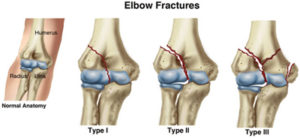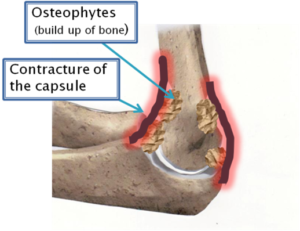Elbow joint is a complex joint and hence elbow surgery is considered as one of the most technically demanding and challenging surgery. Surgical accuracy and caution is paramount whilst undertaking elbow surgeries.
Dr Gautam Tawari is the best elbow surgeon in Mumbai, India. He has worked and trained with UK’s best orthopedic elbow surgeons and specialises in elbow surgeries. He has proficiently performed all kinds of simple & complex Elbow Surgery.
He undertakes elbow surgery like Elbow Replacements, Elbow Arthroscopies, treatment of Elbow fractures / trauma & sports Injuries around the elbow.

Elbow joint is made of three bones, the humerus, radius and ulna.
Elbow fractures occur from trauma like a fall on an outstretched arm, a direct blow to the elbow, or an abnormal twist to the joint beyond its functional limit.
Types
- Radial head and neck fractures: Fractures in the head portion of the radius bone are referred to as radial head and neck fractures.
- Olecranon fractures: These are the most common elbow fractures, occurring at the bony prominence of the ulna.
- Distal humerus fractures: These fractures are common in children and elderly people. Nerves and arteries in the joint may sometimes be injured in these fractures.
Presentation
Usual presentation includes pain, bruising, stiffness, swelling around the elbow, a popping or cracking sound, numbness or weakness in the arm, wrist and hand, and deformity of the elbow bones.
An X-rays of the joint or/and a CT scan is needed to determine the extent of the injury to the elbow joint and allows surgical planning.
Treatment
Surgery is indicated in displaced and open fractures / trauma to realign the bones and stabilise the joint with screws, plates, pins and wires.
Surgical treatment is aimed at maximizing early motion and to reduce the risk of stiffness. Strengthening exercises are recommended to improve the range of motion.
The elbow joint is a type of hinge joint. The normal range of bending (flexion) and straightening (extension) is from 0 to 145 degrees, although the range of motion that we work within for daily activities is only from 30 to 130 degrees (functional range). Loss of extension is usually less disabling than loss of same degree of flexion.
Causes

Intrinsic / Intra-articular Causes (within elbow joint)
- Post-traumatic Osteoarthritis
- Primary Osteoarthritis
- Rheumatoid
- Joint Infection
- Malunions
Extrinsic / Extra-articular Causes (outside elbow joint)
- Burns
- Heterotopic Ossification
- Congenital – arthrogryposis, congenital disloc radial head
The commonest cause of stiffness is after trauma and injury. In fact, some stiffness after an elbow injury is very common. The amount of stiffness is directly related to the degree of initial trauma and the degree of involvement of the joint surfaces.
The ‘Simple’ Stiff Elbow is one that recovers well. The criteria are:
- Mild to moderate contracture (<80)
- No or minimal prior surgery
- No prior ulnar nerve transposition
- No or minimal internal fixation in place
- No or minimal heterotopic ossification (bone in the muscles)
- Normal bony anatomy has been preserved
Treatment
The aim is to give the patient pain-free, functional and stable elbow. This means 30-130 degrees flexion and 100 degrees of rotation.
Physiotherapyinvolves active motion exercises. Ideally this should be with a physiotherapist who has an interest in upper limb rehabilitation. Close consultation with the surgeon is recommended.
Surgeryis indicated when patients are no longer improving in their original posttraumatic rehabilitation program. At least 6 to 9 months should be allowed for the inflammatory phase of soft tissue healing to resolve.
Arthroscopic release is ideal for stiffness due to arthritis and when there has been no previous surgery. However, if there has been a previous internal fixation and there are extrinsic causes for the stiffness open surgery may be required

